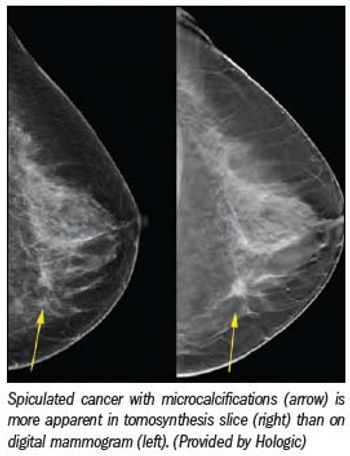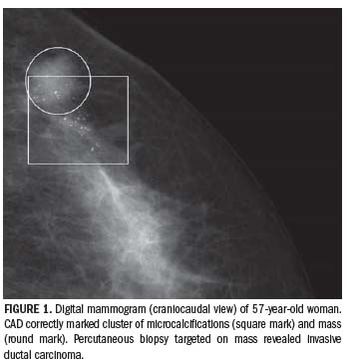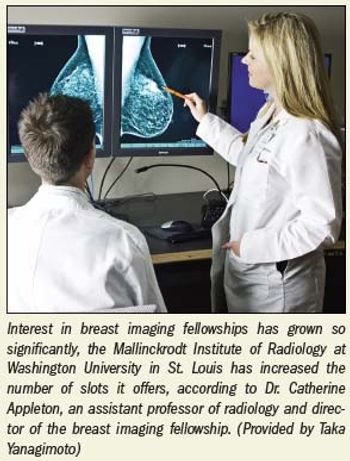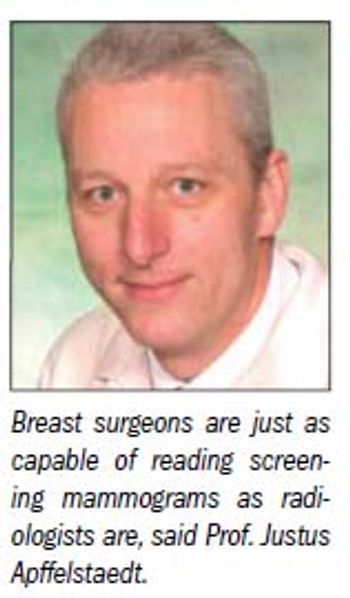
Yearly mammograms greatly reduce the risk of mastectomy following breast cancer in women between the ages of 40 and 50, according to a study presented Wednesday at the RSNA meeting.

Yearly mammograms greatly reduce the risk of mastectomy following breast cancer in women between the ages of 40 and 50, according to a study presented Wednesday at the RSNA meeting.

Hologic has pursued breast tomosynthesis as a commercial modality for the last five years, recruiting luminaries with track records in tomo going back a decade or more. Now, at RSNA 2010, the company is on the brink of achieving that objective.

Screening MRI should be an adjunct to screening mammography in women with a personal history of breast cancer, researchers at the 2010 RSNA scientific assembly in Chicago said.

Hologic is on the brink of realizing its ambition to pioneer the commercial use of 3D mammography in the U.S. The company, which for 25 years has focused on women’s health, announced receipt of an approvable letter from the FDA for its Selenia Dimensions digital mammography tomosynthesis system.

The technological and political evolution of digital mammography will be in evidence on the RSNA exhibit floor.

Combining digital breast tomosynthesis and a laser-based technique called diffuse optical tomography, radiologists may be better able to distinguish malignant from benign lesions in the breast, according to a new study.

For the vast majority of medical imaging devices, passing FDA review is a snap: Show equivalence to a device already on the market, wait a few months, and release the announcement that your new product is ready for U.S. patients. But not for full field digital mammography systems.

Breast tomosynthesis in the U.S. may finally be at hand. In September the FDA's Radiological Devices Panel unanimously agreed that Hologic's digital mammography tomosynthesis system, Selenia Dimensions, is effective and safe.

Computer-aided detection (CAD) tools use software to analyze digital or digitized images to find features associated with the target disease.

Musician Sheryl Crow teamed up with the Pink Lotus Breast Center to create the Sheryl Crow Imaging Center, a state-of-the-art breast imaging center based in Los Angeles featuring the latest advancements in digital screening and diagnostic imaging technologies.

Before Hologic’s 3D digital mammography system can become a commercial product on the U.S. market, the company must develop a program to train physicians on how to interpret this new kind of mammogram.

The landmark breast cancer screening study of women 40-49, published online in Cancer, has proven annual mammography screening of women in their 40s reduces the breast cancer death rate in these women by nearly 30%.

With all the doom and gloom surrounding mammography-lower reimbursement, high threat of malpractice lawsuits-it's easy to assume residents would shy away from the field.

Radiation in any form brings risk. Medical radiation as a screening, diagnostic or treatment tool is designed with safeguards in mind to minimize the risk and maximize the benefit of the test or treatment. For instance, if a patient presents with a breast lump that can be felt but not viewed with mammography or ultrasound, medical professionals must employ the most appropriate diagnostic tools that identify potential cancer.

Some nuclear-based breast imaging exams may increase a woman’s risk of developing radiation-induced cancer, according to a special report appearing online and in the October issue of Radiology. However, the radiation dose and risk from mammography are very low.

Radiologists too often are either unwilling or unable to interpret screening mammography exams, so breast surgeons should learn the specialty and fill in when needed, an international speaker told a group of breast surgeons recently.

MRI detects breast cancer in the contralateral breast for postmenopausal women better than a clinical or mammographic examination, according to a Mayo Clinic study published in the March/April The Breast Journal.

Data continue to accumulate showing that screening mammography rates are declining in the U.S. A survey recently conducted for Diagnostic Imaging by The MarkeTech Group found nearly half (47%) of hospital-based administrators surveyed said there is a decrease in the number of women receiving mammograms at their facility compared to 2009.

Women exposed to radiation therapy for Hodgkin’s disease have a relative risk 7.7 times greater than the general population of developing breast cancer, according to a study presented at the European Congress of Radiology in Vienna, in March.

A new study questioning the efficacy of screening mammography has stirred up an international debate with researchers from around the world challenging its scientific validity.

I very much appreciate Dr. Caruncho’s thoughtful and detailed response to my article in Diagnostic Imaging. It is ironic I wrote the article before the U.S. Preventive Services Task Force published its new guidelines. Their scientifically unsupportable analysis merely reinforced the concerns I expressed in Diagnostic Imaging.

Baum stated after delivering a lecture about the U.K. breast cancer screening in the USA: "I learned a painful lesson that day: that some topics, particularly breast cancer screening, do not lend themselves to polite and rational scientific debate."

As usual, Dr. Kopans' editorial in support of mammography screening is persuasive and compelling; it is also misleading, largely because of the information he withholds.1

As Diagnostic Imaging previously mentioned, most women at high risk for breast cancer come in for their breast MRI. However, claustrophobia and reluctant patients still exist. Below breast imagers offer their tips.

Breast cancer is one of the leading causes of cancer death among women. The risk of breast cancer typically increases with age in most countries.